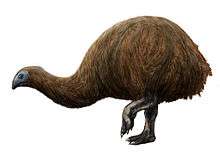Broad-billed moa
The broad-billed, stout-legged moa[3] or coastal moa (Euryapteryx curtus) is an extinct species of moa. These moa lived in both the North and the South Islands of New Zealand, and on Stewart Island. Its habitat was in the lowlands (duneland, forest, shrubland, and grassland).[4] It was a ratite and a member of the Struthioniformes Order. The Struthioniformes are flightless birds with a sternum without a keel. They also have a distinctive palate. The origin of these birds is becoming clearer as it is now believed that early ancestors of these birds were able to fly and flew to the southern areas that they have been found in.[4]
| Broad-billed moa | |
|---|---|
 | |
| Restoration | |
| Scientific classification | |
| Kingdom: | Animalia |
| Phylum: | Chordata |
| Class: | Aves |
| Order: | †Dinornithiformes |
| Family: | †Emeidae |
| Genus: | †Euryapteryx Haast, 1874 |
| Species: | †E. curtus |
| Binomial name | |
| †Euryapteryx curtus | |
| Synonyms | |
|
List
| |
Taxonomy
A 2009 genetic study showed that Euryapteryx curtus and Euryapteryx gravis were synonyms.[5] A 2010 study explained size differences among them as sexual dimorphism.[6] A 2012 morphological study interpreted them as subspecies instead.[7]
The cladogram below follows a 2009 analysis by Bunce et al.:[8]
| ||||||||||||||||||||||||||||||||||||||||
| Emeidae |
| |||||||||||||||||||||||||||||||||||||||
 Skull
Skull
Footnotes
- Owen 1846
- Checklist Committee Ornithological Society of New Zealand (2010). "Checklist-of-Birds of New Zealand, Norfolk and Macquarie Islands and the Ross Dependency Antarctica" (PDF). Te Papa Press. Retrieved 4 January 2016.
- http://nzbirdsonline.org.nz/species/stout-legged-moa
- Davies 2003, pp. 95–98
- Bunce et al. 2009
- Gill 2010
- Worthy & Scofield 2012, p. 87
- Bunce, M.; Worthy, T. H.; Phillips, M. J.; Holdaway, R. N.; Willerslev, E.; Haile, J.; Shapiro, B.; Scofield, R. P.; Drummond, A.; Kamp, P. J. J.; Cooper, A. (2009). "The evolutionary history of the extinct ratite moa and New Zealand Neogene paleogeography". Proceedings of the National Academy of Sciences. 106 (49): 20646–20651. doi:10.1073/pnas.0906660106. PMC 2791642. PMID 19923428.
References
- Bunce, Michael; Worthy, Trevor H.; Phillips, Matthew J.; Holdaway, Richard N.; Willerslev, Eske; Haile, James; Shapiro, Beth; Scofield, R. Paul; Drummond, Alexei; Kamp, Peter J. J.; Cooper, Alan (8 December 2009). "The evolutionary history of the extinct ratite moa and New Zealand Neogene paleogeography" (PDF). Proceedings of the National Academy of Sciences of the United States of America. 106 (49): 20646–20651. doi:10.1073/pnas.0906660106. PMC 2791642. PMID 19923428.CS1 maint: ref=harv (link)
- Davies, S. J. J. F. (2003). "Moas". In Hutchins, Michael (ed.). Grzimek's Animal Life Encyclopedia. 8: Birds I: Tinamous and Ratites to Hoatzins (2nd ed.). Farmington Hills, MI: Gale Group. ISBN 0-7876-5784-0.CS1 maint: ref=harv (link)
- Gill, B. J. (2010). "Regional comparisons of the thickness of moa eggshell fragments (Aves: Dinornithiformes)". Records of the Australian Museum. 62: 115–122. doi:10.3853/j.0067-1975.62.2010.1535.CS1 maint: ref=harv (link)
- Owen, R. (1846). A History of British Fossil Mammals and Birds. London, UK: John Van Voorst.CS1 maint: ref=harv (link)
- Worthy, T. H.; Scofield, R. P. (2012). "Twenty-first century advances in knowledge of the biology of moa (Aves: Dinornithiformes): a new morphological analysis and moa diagnoses revised". New Zealand Journal of Zoology. 39 (2): 87–153. doi:10.1080/03014223.2012.665060.CS1 maint: ref=harv (link)